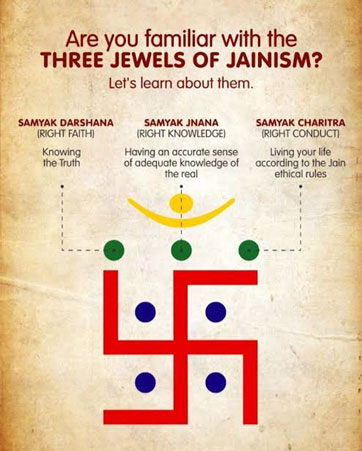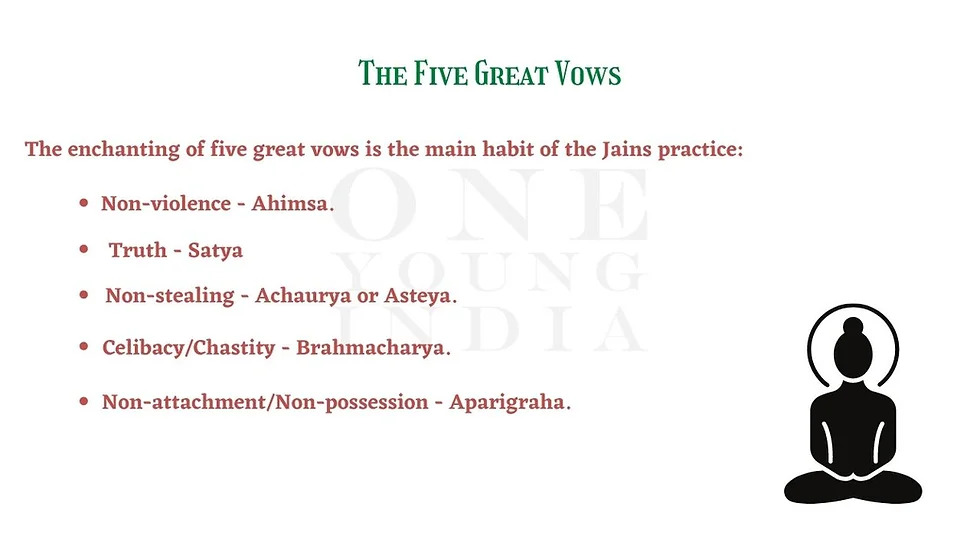- Home
- Prelims
- Mains
- Current Affairs
- Study Materials
- Test Series
Mahaveer Jayanti
Recently, the Vice-President of India greeted the people on the occasion of ‘Mahavir Jayanti’ (April 21st, 2024)
Mahavir Jayanti:
- Festival of Jainism: Mahavir Jayanti, also known as Mahavir Janma Kalyanak is one of the most significant festivals in Jainism, celebrating the birth anniversary of Lord Mahavir, the 24th and last Thirthankara of Jainism.
- Celebrations: Celebrated by Jains around the world, Mahavir Jayanti is observed through religious processions, prayers, chants, and sermons. The day is marked by celebration, reflection, and a renewed commitment to the teachings of Lord Mahavir.
- Commitments: On this day when Jains pledge and vow to practise compassion towards all living beings.
- Mahavir Jayanti promotes the values of tolerance, compassion, and non-violence towards all and serves as a reminder for people to think about their actions and aim to live a life of righteous nature and morality.
- Donations are also made in order to contribute towards saving animals from slaughter.
Historical Background:
- Birth: He was born as Vardhamana into the royal family, to King Siddhartha and Queen Trishala, in the early part of the 6th century BCE in Kundagrama, which is in modern-day Bihar, India.
- He was born on the Trayodashi (13th) date of Shukla Paksha (the bright half) of the Hindu month of Chaitra, which falls in late March or early April as per the Gregorian calendar.
- His birth date, however, is sometimes debatable, the Swetambar Jains believe that he was born in 599 BC, while the Digambar Jains believe he took birth in 615 BC.
- Spiritual Awakening: Mahavir, or the ‘great hero,’ renounced his royal status and familial ties at the age of 30 to seek spiritual awakening.
- After 12 years of intense meditation and ascetic life, Mahavira attained Kevala Jnana (omniscience or supreme knowledge) hence, was also called Sage Vardhamana and preached non-violence (ahimsa) and spent the next 30 years travelling around India to teach his philosophy.
- He delivered his first sermon at Pava.
- Symbol: A symbol was associated with every Tirthankara and Mahavira’s symbol was a lion.
- Enlightenment: He got his name for his exceptional control over his senses. Seeking truth and spiritual freedom, he attained enlightenment (Nirvana) at the age of 72 in 468 B.C. at the Pavapuri in Bihar.
- Contribution: Mahavir, renowned as a teacher who propagated Dharma in Jainism.
- He is known for his teachings of non-violence, compassion, and the importance of leading a simple and austere life.
- His core teachings included Ahimsa (non-violence), Satya (truth), Asteya (non-stealing), Brahmacharya (chastity), and Aparigraha (non-attachment), which later became the fundamental principles of Jainism.
- Important Disciple: Indrabhuti Gautama was the main disciple of Mahavira, who wrote his master’s teachings for the benefit of the world.
Jainism:
- Origin: Jainism came to prominence in the 6th century B.C. when Lord Mahavir propagated the religion.
- The word ‘Jain’ is derived from jina or jaina which means the ‘Conqueror’.
- The doctrine of Jaina is older than the Buddhist doctrine.
Cause of Origin:
- Rigidity of Hinduism: Hinduism had become rigid and orthodox with complex rituals and dominance of Brahmins and Kshatriyas reacted against the domination of the Brahmanas.
- Use of Iron: Spread of the new agricultural economy in north-eastern India due to the use of iron tools.
- Tirthankaras: Tirthankaras are people who had attained all knowledge (Moksha) while living and preached it to the people and there were 24 Tirthankaras.
- The first Tirthankara was Rishabnatha and the last – 24th Tirthankara was Vardhaman Mahavir.
- Belief: Jains believe that Jainism is an eternal (sanatan) religion (dharma) with the tirthankaras guiding every cycle of the Jain cosmology.
- Parasparopagraho Jīvānām (the function of souls is to help one another) is the motto of Jainism.
- The Concept of God: Jainism believes in God but does not believe in God as a creator, survivor, and destroyer of the universe.
- However, for Jainism God is lower than Jina (Lord Mahavir).
- Tenets: Jainism mainly aims at the attainment of liberation, for which no ritual is required. It can be attained through three principles called Three Jewels or Triratna as follows:
Right Faith (Samyak Darshan)
Right Knowledge (Samyak Jnana)
Right Action (Samyak Charitra)

Doctrines:
- Ahimsa: Non-injury to living being
- Satya: Do not speak a lie
- Asteya: Do not steal
- Aparigraha: Do not acquire property
- Brahmacharya: Observe continence

- Spread: Jainism spread through Sangha, it consists of both women and men.
- Patronage: Under the patronage of Chandragupta Maurya, Kharavela of Kalinga and the royal dynasties of South India such as the Ganges, the Kadambas, the Chalukyas and the Rashtrakutas.
Sects/Schools of Jainism:
- Major Sects: Jain order has been divided into two major sects: Digambara and Shwetambara.
Digambaras:
- Monks of this sect believe in complete renounce of clothes.
- Male monks do not wear clothes while female monks wear unstitched plain white sarees.
- They follow all five vows i.e., Satya, Ahimsa, Asteya, Aparigraha and Brahmacharya.
- They believe that women cannot achieve liberation.
- Exponent: Bhadrabahu was an exponent of this sect.
- Major Sub-Sects: Mula Sangh, Bisapantha, Terapantha, Taranpantha or Samaiyapantha.
- Minor Sub-Sets: Gumanapantha, Totapantha.
Shwetambara:
- Monks of this sect wear white clothes.
- They follow only 4 vows (except brahmacharya).
- They believe that women can achieve liberation.
- Exponent: Sthulabhadra was an exponent of this sect.
- Major Sub-Sects: Murtipujaka, Sthanakvasi, Terapanthi
Important Terms Related to Jainism:
- Asrav: Inflow of karmas to the soul that occurs at every second in life.
- Samvara: Stoppage of the influx of the material karmas into the soul consciousness.
- Nirjara: Shedding or removal of accumulated karmas from the atma (soul), essential for breaking free from samsara, the cycle of birth-death and rebirth, by achieving moksha, liberation. It is one of the important principles or tattva in Jain philosophy.
- Sallekhana: It is the religious practice of voluntarily fasting to death by gradually reducing the intake of food and liquids. It is also known as Santhara.
- Kaivalya: It is also known as Kevala Jnana, means omniscience in Jainism and is roughly translated as complete understanding or supreme wisdom.
- Anekantavada: It emphasises that the ultimate truth and reality is complex, and has multiple-aspects i.e., “theory of plurality”.
- It refers to the simultaneous acceptance of multiple, diverse, even contradictory viewpoints.
- Syadvada: Syadavada literally means the method of examining different probabilities. Here, all judgments are conditional, holding good only in certain conditions, circumstances, or senses.
- It believes in Seven modes of prediction (Saptabhangi Nayavada).
- Difference between Anekantavada and Syadvada: Anekantavada is the knowledge of all differing but opposite attributes whereas Syadvada is a process of the relative description of a particular attribute of an object or an event.
Historical Jain Councils:
- First Jain Council: It was held at Patliputra in 3rd Century B.C. and was presided by Sthulbhadra.
- Second Jain Council: It was held at Vallabhi in 512 A.D. and was presided by Devardhi Kshmasramana.
Difference of Jainism from Buddhism:
- God Existence: Jainism recognised the existence of god while Buddhism did not.
- Varna System: Jainism does not condemn the varna system while Buddhism does.
- Belief System: Jainism believed in transmigration of soul i.e., reincarnation while Buddhism does not.
- Path Followed: Buddha prescribed the middle path while Jainism advocates the extreme path, even completely discarding the clothes i.e. life of austerity.
Contribution of Jainism :
- Language & Literature: They helped in growth of Prakrit and Kannada language.
- Vardhaman Mahavir preached in ‘Ardha-Magadhi’ language, the language of the common man.
- Kalpasutra was written by Bhadrabahu and contains biographies of Tirthankaras.
- Jain literature is mainly written in Prakrit language.
- Teachings of tirthankara before Mahavira were known as Purva.
- Jain literature is called Jain Agamas (canonical text based on Mahavira’s teachings).
Classification of Jain Literature:
- Agam or Canonical Literature (Agam Sutras): It consists of many texts, which are the sacred books of the Jain religion.
- They are written in the Ardha-magadhi, a form of Prakrit language.
- These agamas are further divided into Angas, Mulasutra, Upangas, Prakirnaka Sutra, Chedasutra and Ulikasutras.
- The canonical Jain literature is claimed to have started from Adinath, also known as Rishabhnath.
- Non-Agam Literature: It consists of commentary and explanation of Agam literature, and independent works, compiled by ascetics and scholars.
- They are written in many languages such as Prakrit, Sanskrit, Apabhramsa, Old Marathi, Rajasthani, Gujarati, Hindi, Kannad, Tamil, German, and English.
- Philosophy: They introduced a new philosophy – syadvada.
- Art & Architecture: Statue of Gomateshwara (Shramanbdlogola), temples of Khajuraho and Abu and Tiger cave of Udayagiri and Indra Sabha of Ellora are significant contributions of Jainism.
- Manasthambha: It is found in the front side of the temple, having religious importance with an ornamental pillar structure carrying the image of Tirthankar on top and on all four cardinal directions.
- Basadis: Jain monastic establishment or temples in Karnataka.
- Economy: Jainism contributed to the growth of the trading community.
Significant Architectural Figures of Jainism:
Layana/Gumphas (Caves):
- Ellora Caves (Cave No. 30-35)- Maharashtra
- Mangi Tungi Cave– Maharashtra
- Gajpantha Cave– Maharashtra
- Udayagiri-Khandagiri Caves– Odisha
- Hathi-gumpha Cave– Odisha
- Sittanavasal Cave– Tamil Nadu
Statues:
- Gomateshwara/Bahubali Statue– Shravanabelagola, Karnataka
- Statue of Ahimsa (Rishabnatha)– Mangi-Tungi hills, Maharashtra
- Jinalaya (Temple):
- Dilwara Temple: Mount Abu, Rajasthan
- Girnar and Palitana Temple: Gujarat
- Muktagiri Temple: Maharashtra
Contemporary Relevance of Jainism:
- Ahimsa (non-violence): Jainism preached non-violence toward all living beings. This value is significant in today’s nuclear world to attain long lasting peace in the society.
- It can also help to counter growing violence and terrorism.
- Non-violence is about treating all living beings as equal. The concept of equality is the core of the theory of non-violence.
- Killing of the plant kingdom also comes under the ambit of Himsa. As the world marches on towards creating a sustainably developed world, the world must keep our forests intact.
- The Philosophy that lies behind the creation of UNESCO resembles the thought of Jainism, which declares that, “Since wars begin in the minds of men. It is in the minds of the men that the defense of peace must be constructed.”
- Jainism believes that all living beings have an equal right to lead a peaceful life.
- Aparigraha (non-possession): Aparigraha holds the answer to the problems emanating from rampant consumerism, i.e., the depletion of natural resources, climate change, and biodiversity loss, among others. Curtailing the consumption of unnecessary goods directly addresses this issue.
- This value can help in reducing the issue of global warming by doing away with unwanted luxuries, which produce carbon emissions.
- Today, newspapers are filled with concerning incidents such as murders, rapes, and fraudulent activities. The main reason for these crimes is the want for more. These activities not only disrupt the social balance but also degrade the societal values of those individuals.
- By inculcating this value, these issues can help in combating such serious crimes.
- Anekantavada: It highlights the spirit of intellectual and social tolerance.
- Religious tolerance is required, particularly in India, where hundreds of religions and ideas coexist. Blasphemy, mob lynching, and religious rioting can be reduced if everyone understands and adheres to this doctrine.
- The doctrine of Triratna: It is relevant to liberate humans from the subjugation to liberty and freedom.
Conclusion:
Jainism holds an important position and has been rightly called an ethical religion, which is applicable and relevant today as it was thousand of years ago. The Jain ethos comprehends all aspects of human life and leads to social development, individual happiness, economic advancement and political harmony.









 Latest News
Latest News
 General Studies
General Studies